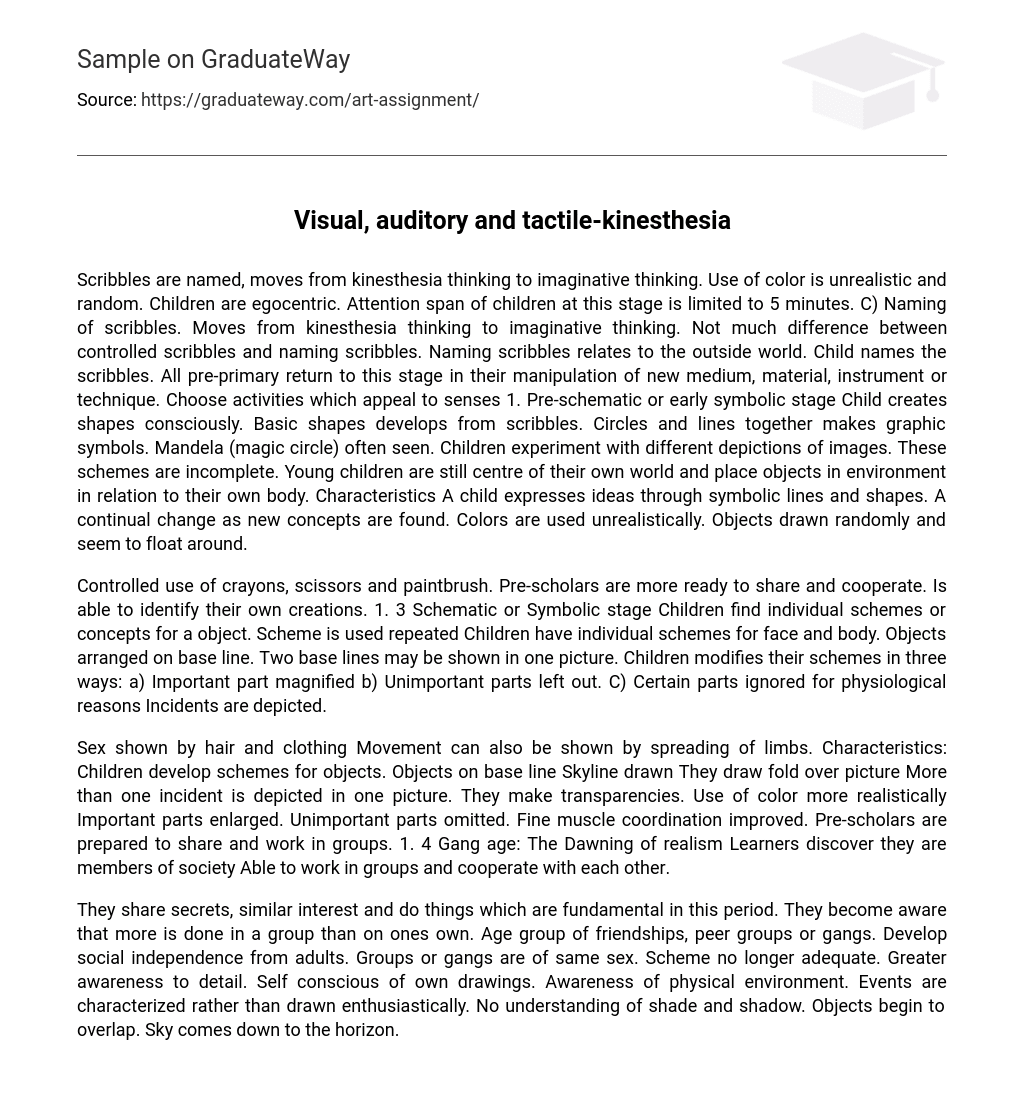Scribbles are named, moves from kinesthesia thinking to imaginative thinking. Use of color is unrealistic and random. Children are egocentric. Attention span of children at this stage is limited to 5 minutes. C) Naming of scribbles. Moves from kinesthesia thinking to imaginative thinking. Not much difference between controlled scribbles and naming scribbles. Naming scribbles relates to the outside world. Child names the scribbles. All pre-primary return to this stage in their manipulation of new medium, material, instrument or technique. Choose activities which appeal to senses 1. Pre-schematic or early symbolic stage Child creates shapes consciously. Basic shapes develops from scribbles. Circles and lines together makes graphic symbols. Mandela (magic circle) often seen. Children experiment with different depictions of images. These schemes are incomplete. Young children are still centre of their own world and place objects in environment in relation to their own body. Characteristics A child expresses ideas through symbolic lines and shapes. A continual change as new concepts are found. Colors are used unrealistically. Objects drawn randomly and seem to float around.
Controlled use of crayons, scissors and paintbrush. Pre-scholars are more ready to share and cooperate. Is able to identify their own creations. 1. 3 Schematic or Symbolic stage Children find individual schemes or concepts for a object. Scheme is used repeated Children have individual schemes for face and body. Objects arranged on base line. Two base lines may be shown in one picture. Children modifies their schemes in three ways: a) Important part magnified b) Unimportant parts left out. C) Certain parts ignored for physiological reasons Incidents are depicted.
Sex shown by hair and clothing Movement can also be shown by spreading of limbs. Characteristics: Children develop schemes for objects. Objects on base line Skyline drawn They draw fold over picture More than one incident is depicted in one picture. They make transparencies. Use of color more realistically Important parts enlarged. Unimportant parts omitted. Fine muscle coordination improved. Pre-scholars are prepared to share and work in groups. 1. 4 Gang age: The Dawning of realism Learners discover they are members of society Able to work in groups and cooperate with each other.
They share secrets, similar interest and do things which are fundamental in this period. They become aware that more is done in a group than on ones own. Age group of friendships, peer groups or gangs. Develop social independence from adults. Groups or gangs are of same sex. Scheme no longer adequate. Greater awareness to detail. Self conscious of own drawings. Awareness of physical environment. Events are characterized rather than drawn enthusiastically. No understanding of shade and shadow. Objects begin to overlap. Sky comes down to the horizon.
Attempt to show depth through the size of objects. Awareness of clothing detail. Less exaggeration, distortion, and omission of body parts. Learners begin to deal with abstract objects. Base line disappears and plane emerges. 2. 1 Why should early childhood development teachers not use food in art activities, such as painting and collage? Food is expensive. Many countries have a shortage of good healthy food. In CD children are encouraged to respect food and consider themselves blessed, to have so much and nutritional food to eat Food art can be questioned on moral and ethnic grounds.
The use of certain food items COUld offend some cultural groups, who use that food for a religious or ethnic celebration. Food artwork can not be displayed in a classroom, as this artwork will ultimately be thrown away. 2. 2 Identify three major learning styles and select the one that best describes the way you learn? All children have different learning styles or methods in which they process information. Therefore it is important to identify the learning styles of your students before you can present a lesson, in order for the lesson to be effective and valuable.
Children respond to information in different ways. The three ways in which a teacher can identify the learning style of a child are: 1. Visual Children who learns visually,Looks at the entire picture and not at individual pieces. They tend to be holistic thinkers. They learn more when images and words are presented e. G. Photos, pictures. These children have a love for reading, writing and drawing. 2. Auditory Children with auditory strength tend to be analytical thinkers. They are good at listening and speaking.
Tend to enjoy discussions with other learners, sharing what they know, participating in discussions with teacher and learns from others. Follows oral instruction easily. 3. Tactile-kinesthesia Children with a tactile- kinesthesia strength will learn best when they using their hands and bodies. They learn best through hands on activities and are holistic learners. They learn by doing things and not by sitting and listening to someone. These learners love role-play and determination of a theme or story. Would say that my learning style is a combination of all three styles, visual, auditory and tactile-kinesthesia.





